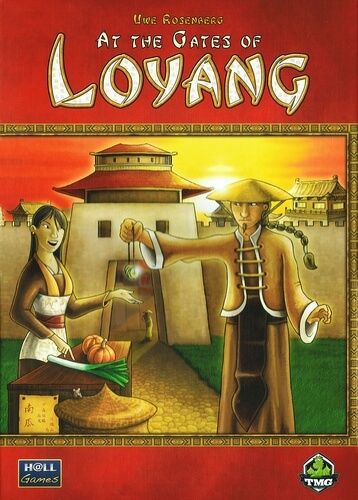
At the Gates of Loyang
At the Gates of Loyang is a strategic resource management game where players become farmers and merchants in a thriving city. During the game, you must plant, harvest and sell a variety of products to meet customer demands. The cards represent fields, customers and helpers, and the selection mechanics involve a bidding system that adds a competitive element. Each round, players receive two cards, discarding one and making the other available to everyone, which creates a constant dynamic of negotiation. The fields you cultivate produce goods, and for each full field, you harvest one unit per round. What's more, you can carry out different actions with the cards you have, with no turn limit, which gives you flexibility in your game strategy. At the end of each turn, the money earned can be invested in victory points, and the most cunning player who achieves the highest score at the end of the game will be the winner. The decisions you make in At the Gates of Loyang shape your path to prosperity.Artists: Klemens Franz;
Designers: Uwe Rosenberg;
Date: 2009
Note: 7.4
Mechanics: Collecting Sets, Open Buy, Contracts, Loans, Market, Shift order: Progressive, Income, Solo
Topics: Economy / Production
Table of Contents
- How to Play
- Tips for playing
- Game mechanics
- Game components
- Additional Information
OBJECTIVE OF THE GAME
Tips for playing
Here are some tips for doing better in the game At the Gates of Loyang:
- Prioritize regular customers to establish a consistent source of income throughout the game.
- Use your help cards wisely to maximize profit and minimize risk in difficult rounds.
- Diversify your crops to meet different customer demands and avoid crop losses.
- Sell at the market whenever possible to maximize your income and free up space for new crops.
- Plan ahead to avoid shortages, ensuring that you have the right products at critical times.
Video about the game
GAME mechanics
- Collecting Sets - Players grow a variety of vegetables in their fields and need to combine them efficiently to satisfy the diverse demands of regular and occasional customers. Forming viable sets of vegetables is crucial to maximizing profits and expanding the business over the course of the game.
- Contracts - In the game, players have the opportunity to establish contracts with regular customers, which offer a fixed income in vegetables when fulfilled in all subsequent turns. Fulfilling contracts consistently is essential to maintaining a steady revenue stream.
- Loans - Players can take out loans to cover immediate costs or invest in larger quantities of vegetables and improvements. However, these loans come with interest charges that can significantly impact the final profit, requiring careful strategic planning.
- Market - Players can freely buy and sell vegetables on the market. Prices can vary, requiring tactical decisions about when to buy or sell certain vegetables to maximize profits. The market offers flexibility to adjust strategy during the game.
- Shift Order: Progressive - The order of the turns is determined by the players' initial choice to acquire action cards. Those who choose less valuable cards have priority in the next phase, creating a dynamic system of choice and strategy based on the value of the cards available.
- Income - Each turn, players harvest vegetables from their fields. Efficient planning of planting and harvesting is vital to ensure a constant supply of vegetables needed to fulfill contracts and take advantage of market opportunities.
- Open Buy - Vegetable cards can be purchased openly during the buying phase. Players must strategically choose which vegetables to include in their hand in order to complete sets, fulfill contracts and adapt to changes in the game.
- Solo - The game offers a single-player variant while maintaining the same core mechanics. The solo challenge involves managing resources and contracts optimally to achieve the highest possible score, facing different scenarios and difficulties.
Game components
See all the items in the game below At the Gates of Loyang:
- 01 rulebook
- 04 T-shaped player boards (prosperity trail and market)
- 12 contentment markers (blue/red)
- 24 $1 coins (small)
- 14 $5 coins (large)
- 237 wooden tokens:
- 48 wheat (yellow)
- 46 pumpkin (orange)
- 44 radish (red)
- 36 cabbage (white)
- 32 beans (light green)
- 25 leeks (dark green)
- 04 scorecards (prosperity trail)
- 02 starting player tokens (one major and one minor)
- 120 letters:
- 04 warehouse/cart cards
- 04 shift summary cards
- 06 loan letters
- 36 private fields (green cards):
- 08 fields each (with 3, 4, 5 and 6 spaces)
- 70 action cards (brown cards):
- 06 common fields, 2 of each (with 3, 4 and 5 spaces)
- 14 market stalls (orange)
- 14 regular customers (blue)
- 14 occasional customers (red)
- 22 assistants (beige)
Additional Information
- Ludopedia link: https://ludopedia.com.br/jogo/at-the-gates-of-loyang
- Link Tabletopia:
- Amazon Brazil link: Comprar At the Gates of Loyang
- Amazon USA link: Comprar At the Gates of Loyang


